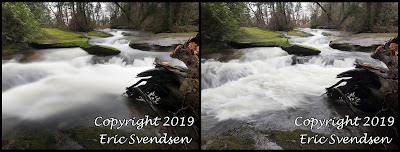 |
| Top: No flash. Bottom: Camera's built in flash used. |
I photographed my friend while enjoying the quiet of the shoreline. The sun was just off to the left of the camera; you can see how Bert's face is partly in shadow. I had my camera set to manual exposure mode, and was using a polarizer filter to help bring out the colour of the leaves and sky. I took two photographs. One without the built-in flash and one with it.
With the harsh lighting producing strong shadows, I decided to take two photographs. The first was an exposure without using fill flash, the second used the camera's built-in flash to soften the dark areas on my subject. I often will take two shots of something, a before and after picture of sorts, where I will change one camera setting between shots. It can be focal length, aperture or shutter speed, flash, or perhaps ISO. Investigating the differences afterwards helps me understand the nature of photography.
No flash was used in the top image. You can see the dark shadows present on the face, shirt, and jacket. I popped up the camera's flash for the second photo. It filled the scene nicely, rendering the face, shirt, and jacket with less shadow. Using flash in this way is called fill-flash, and it can make an enormous difference in way an image looks.
Built-in flashes are, by their very nature, weak. They often will not have enough power to properly illuminate a subject that is too far away, shot using a small aperture, or diminished because of flash or lens filtering (such as a diffuser or a polarizer filter). Even so, they often will make a small difference; enough to have a significant impact as in the situation above. I used a wide angle lens (28 mm on a full frame camera) so I was relatively close to my buddy. The aperture was as wide open as I could get it as my shutter speed was set to 1/200th of a second, the camera's flash-synch speed. These helped to make the flash somewhat viable, even though it was not quite powerful enough.
Next time you are out shooting in the sun, try popping up your flash when shooting portraits. If you are using your built-in unit, be sure to:
- pop up the flash
- use shutter priority
- set the ISO to 100 if possible
- turn the command dial to get the highest shutter speed possible (1/200 or 1/250 usually)
- make sure any hat you are wearing does not push the flash down a bit as it might not actuate
- use a wide angle setting
- be sure you are modestly close to your subject (4 - 6 feet)
- try not to shoot in a strong backlit situation (sun not visible in viewfinder)
Take a couple of shots, one with and one without the flash. Then look at your images. Enlarge them to see details on faces. Was there a difference? Congratulations, you just used fill flash successfully!
-






















